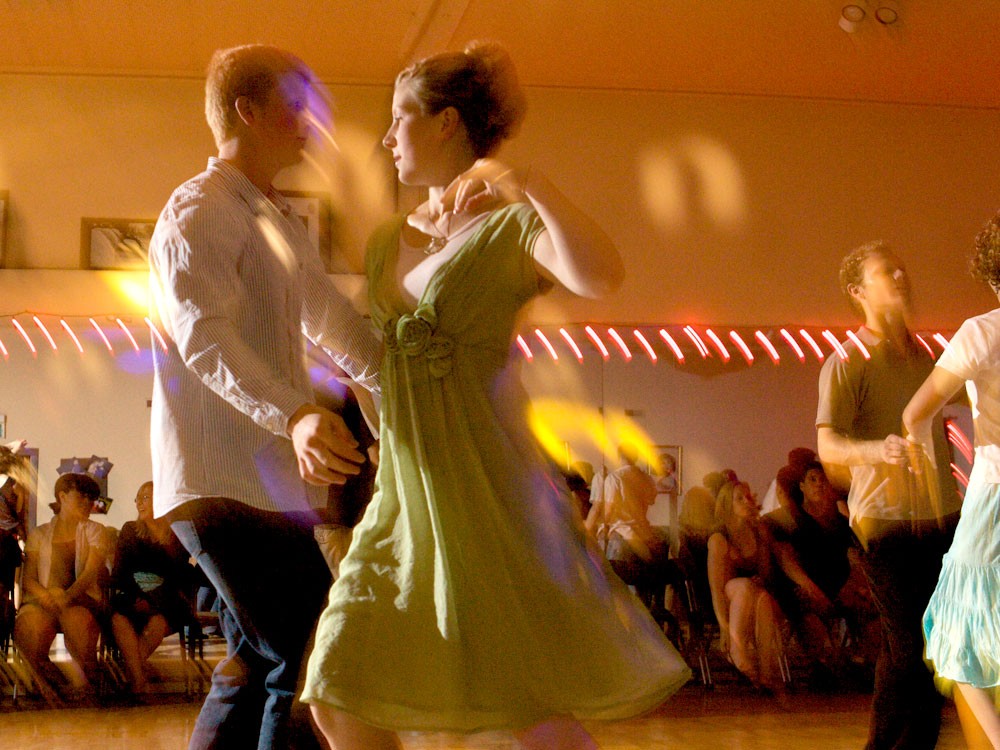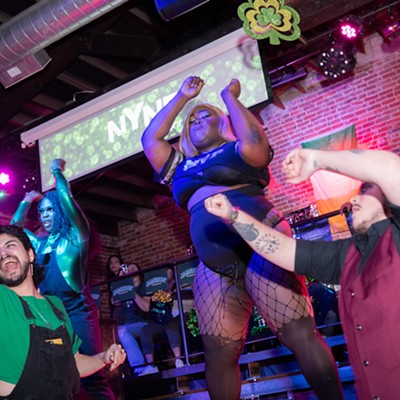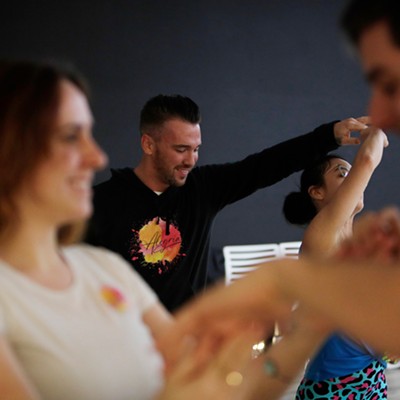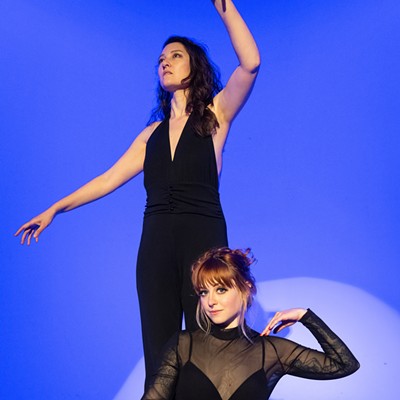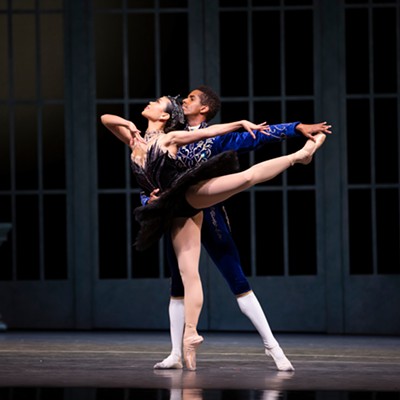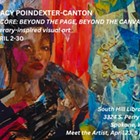This, frankly, isn’t the ideal location for the timeless art of dance. It’s jammed in a strip mall of ugly asphalt and cigarette butts, neighboring a coin-op laundromat and a smoke shop. It’s across from a McDonald’s, where a shirtless man stomps across the parking lot, drunkenly screaming at his woman.
It’s the hollowed-out husk of a former pawn shop, still sporting metal bars on the windows. But below those bars, under a zig-zag of duct tape covering a crack in the glass, sit dozens of dusty 15-year-old social dance competition trophies.
Beyond the bars, it’s a blur of sweat and lights, of salsa beats and swing rhythms, of spins and twirls and dips and lifts.
This is the Spokane Dance Company, where dance is more about swaying hips than thrusting them. Weekdays, it’s an instructional school. Friday nights, it’s a celebration of an art form that struggles to survive in Spokane.
To the dancers, shifting effortlessly from salsa to tango to waltz to swing, the surroundings outside don’t matter — only the hardwood floor, the beat and the harmony with your partner.
A single embrace is all it takes. Preconceptions and assumptions melt away. One dancer instantly feels the skill of the other. From there, they’re off, communicating with each other in a wordless, almost-lost language. A serpentine sashay of the hips, an arched eyebrow, a half-smile, a steamy glance, their bodies rolling in time — he slides his hand up to her forearm, a subtle signal, then he twirls her. She spins three, four, five times, whirling like a top. They embrace again, and the dance continues.
It seems choreographed, but they’ve never met before. It’s almost static electricity, dancer Nikki Gonzales says, flowing from wherever their bodies touch, that tells them — instinctively — what to do.
You’ll find dancers in the Dance Street Ballroom every month, with the Spokane Swing Dance Club on a Sunday, with Simply Dance on a Saturday or at Ichiban Sushi Lounge on a Thursday.
But tonight, they dance in the kingdom of Glenn Braunstein, divisive figure, opinionated instructor and a cornerstone of the Spokane dance scene.
“Almost every teacher in this town has been trained by me,” Braunstein says. “Let’s put it this way: I don’t know if I’m the godfather [of Spokane dancing,] but I’m the guy who everybody wants to beat.”
He’s been obsessed with dance ever since his days as a disc jockey in Spokane during the heyday of disco. He rattles off the big names who’ve trained him and the big names he’s trained.
Braunstein, at one time, dreamed of purchasing the other businesses in the strip mall and turning the whole thing into a big restaurant/dance studio combo venue. He wanted to return to the glamour of the Fred Astaire days — where dates meant dressing up, fancy dinner and dancing to a live band.
But now, that dream’s faded away.
“Dancing in Spokane,” he sighs, “is just about done.”
Empty Floors
You’ll hear the frustration with the city from numerous area dancers. We’re not large enough to sustain niches after fads, Braunstein says. We’re isolated, says Jim Renn, one of the instructors. We have no business travelers bringing new dance styles, don’t have the Latin American population to drive salsa music, he says.
Swing dancer Colleen “Swing Alleycat” Robinson says Spokane offers few careers that give the money and time to sustain the dancing life past age 30.
“In this area, [swing] is danced by college students,” Robinson says. “That has to do with what Spokane is. Disposable income comes from kids who have free time.” And after four years, those college students leave.
Renn and Caitlin McKenna, dancers from two separate studios, both use the word “drought.”
Used to be, there’d be social dances at Spokane Dance Company three times a week instead of just one. Braunstein used to teach a class called “Swango” — a cross of Argentine tango and West Coast Swing — but not anymore. The college classes he teaches at Eastern and Gonzaga have fallen by more than 40 percent.
In fact, on July 20, Braunstein sent an e-mail titled “Time to Reinvent the Spokane Social Dance Scene,” saying the Spokane Dance Company plans to move to a smaller building due to the economy and Spokane’s “mediocre” interest in dance. Aside from Glenn and his wife, all of Spokane Dance Company’s instructors will be let go, though they will be able to offer their own independent private lessons. The last dance in the pawn shop location will be Aug. 27. (Braunstein declined to comment on the downsizing, saying nothing’s set in stone yet.)
The problem is, sparse dance attendance leads to even sparser attendance.
“Crowds breed crowds,” Braunstein says. “People walk in, this place is kinda dead. Everywhere you look, [dancing] is dying, dying, dying.”
He sees society’s social graces decaying with it. In fall of 2005, Central Valley, Mt. Spokane, Lewis and Clark, and Ferris high schools all banned informal mixers after chaperones had been unable to convince students to abandon grinding. But students kept grinding, Braunstein believes, because they don’t know any other way.
“Appropriate social interaction, a safe way to date, not just for kids but adults ... that’s what’s going to go away, as dancing fades,” Braunstein says.
Endurance
Braunstein’s seen the temporary power of fad. He’s seen the disco days and the country fad, the Lindy Hop rage and the salsa craze. He’s seen Spokane fleetingly fall in love with dance, temporarily excited by Saturday Night Fever, Dancing with the Stars or an especially swingin’ GAP commercial.
These are not the heydays. These are the days when the fads begin to fade and the crowds begin to dwindle. Those who are left are the swing dancers who caravan to Pullman for Thursday Lindy Hop, the salsa dancers who fly to L.A. for massive “salsa congress” conventions.
Those are dancers like Nicholas Kasbar, who’s been dancing since his parents lugged the introvert to salsa when he was 15. He seeks dancing wherever he goes — New York, Miami, San Diego. He walks into a club in Guatemala. He doesn’t speak Spanish. But he speaks salsa.
“They went crazy,” Kasbar says, “The gringo can dance! The gringo can dance!”
But good dancers run into a problem: It takes two to tango. A city with few great dancers is a city with few great dance partners.
“The higher you go up the ladder, the smaller the group becomes,” Robinson says.
Miranda Sondheim breaks into a grin as Renn, perhaps the best salsa dancer in town, lifts her through the air during a private practice at Spokane Dance.
“One-two-three-four, five-six-seven,” Renn says to her, training his potential new dance partner. “Could you put more pressure on your right hand? ... You see how fast I turn there?”
He’s had 10 dancing partners over the years. Each time he spends months, even years, training them. But then they leave, whether it’s for a job or a marriage. Maybe, like Lindy Hop dancers Ben White and Trevor Welsh, they leave for the bigger city with the bigger dance scene.
Well, they leave if they can.
“If it wasn’t for family, I don’t think I’d last here more than six months,” Braunstein says. “I’d want to go somewhere where my talents are appreciated more.”
A Broader View
Braunstein’s pessimism isn’t universal. Several local instructors and dancers report slight increases in their numbers, driven by popular shows like Dancing with the Stars.
The Spokane Dance Company, after all, has competitors. There is the bevy of private teachers — some well-trained, some not — waiting to offer their services on the Spokane DanceList Yahoo group. There’s the long-running Spokane Swing Dance Club. And there are studios like Dance Street Ballroom, full of dancers training for weddings, where revenue is up.
Simply Dance’s Saturday salsa nights, owner Marianna Seney says, have been a success. Though Spokane is not a city that desires lengthy, intense dance instruction, it does seem to enjoy dancing for fun.
So she adapted. After $10 and $12 dances failed to bring in large numbers2, Seney instituted $5 Saturday Night Salsa dances — half of what the Spokane Dance Company charges — and dialed down the intensity. The lessons were basic: Teach a few simple steps and finish with one snazzy move. Simply Dance lacks Spokane Dance’s no-jeans-or-sneakers dress code. If Spokane Dance Company is about precision and perfection, local dancers say, Simply Dance is about learning just enough to have a good time.
The result: On most Saturday nights, Simply Dance brings in 90 to 120 dancers. Many of them are teenagers, some as young as 14.
But Simply Dance DJ Caitlin McKenna notes a caveat: “They don’t come back.” They learn just barely enough to make it for an hour, then get bored and leave.
At the A Club, owner Steffan Wachholz is confident enough of Spokane’s potential that he just implemented Latin nights every Friday and Saturday, with Latin dancing lessons on Friday. Others — Uno, Ichiban’s, Zola, Bluz at the Bend — also host salsa or swing dance nights.
But there are far fewer such locations than there used to be, Braunstein says. Bars don’t always like dancers. Good dancers often don’t make good drinkers. Some dancers strut into bars with a free cover, take up space, and don’t buy a thing.
“Those are cheapies,” Braunstein says. “I’ve watched them run so many bars out of business.”
Stepping on Toes
Good dance is infused with emotions. There’s glee in swing, seriousness in waltz, anger tousled with passion in tango. Some people dance for exercise or competition, others because they can’t hear the swagger of a swing song or the heat of a salsa number without being seduced by the rhythm.
But not everything is so in sync. At the Simply Dance salsa night, McKenna plays “Fireflies,” a synthpop song by Owl City.
“Nice salsa song,” a heckler sarcastically calls out.
It has a salsa-worthy beat, she says, but it’s hardly traditional. Some dancers are purists — don’t expect to hear Lady Gaga played at Spokane Dance Company — while others welcome contemporary danceable music. Such disagreement temporarily killed tango dancing at Simply Dance. Salsa dancers stopped attending Thursday Uno’s salsa nights, frustrated the DJ was playing too much Latin music (there’s a difference). Some West Coast Swing dancers, Robinson says, can’t stand those Lindy Hop punks with their messy limb-flailing and floor-hogging style.
The already small group of social dancers is thus divided — by dance technique, by music, by studio allegiance.
Studios squabble over that rare resource, the dancer willing to pay for instruction.
Spokane Dance Company used to allow a trainee’s “friends” to sit in on lessons. Not anymore. Teachers from other studios were sitting in and taking notes. Spokane Dance Company used to print a syllabus, but stopped after those syllabuses began popping up at other studios — with the Spokane Dance logo still on them.
Seney, an instructor who once received dance training from Braunstein1, says some studios insult the other studios and pressure their students against visiting them.
Two dancers in the last three months were banned permanently from Spokane Dance after recruiting for other studios during Braunstein’s dances.
“You don’t go to Safeway and tell them they have a big meat sale at Albertsons,” Braunstein says.
It’s an issue that former U.S. Salsa Champion Rick Pride identifies without coaxing.
“I think the only hole I see [in Spokane] is some of the dance studios here still have that small-town mentality that they’re competing with each other,” Pride says. “If they could just get along, they’d be a lot better off.”
The intensity of the rivalry was enough to inspire Caitlin McKenna to write a 46-page Gonzaga thesis paper titled “Turf War on the Dance Floor: Spatial and Symbolic Boundary Maintenance in Social Dance.”
She describes Thursday Salsa Nights at what is now Uno Supper Club and Lounge, where one studio would attempt to use elbows and heels to establish a bubble, driving the other studio off the crowded dance floor.
But today, McKenna says, for the veteran dancers, the rivalry has long since cooled. There just aren’t enough decent dance partners to allow division.
Maniacs on the Floor
Christian Grupp — thick black glasses, hair slicked to the side, clipped precise speech— says he’s a “serial killer” of competitive hobbies owing to his intense devotion. He reels off his resume of obsessions: Chess, classical piano, golf, swimming, water polo, body building, pool, snowboarding, choir and martial arts.
Now competitive social dance is in those crosshairs. In a single week and a half, he’s spent more than 25 hours dancing: Nine hours of private lessons, two hours of group lessons, 10 hours of social. It’s a mad dash to train for the Seattle Star Ball, the first weekend of August.
“I haven’t slept for three days,” Grupp says.
Grupp is that crucial obsessed new dancer, the type that could revitalize the Spokane dance scene. The question is, how do you find those types and make them want to dance?
At a “Congas for Cancer” event in front of Latah Bistro, Son Dulce — an 11-piece salsa band — plays traditional salsa music live as salsa dancers dance in front. A woman approaches the salsa dancers, says they look like they’re having so much fun and tells them that she’s vowed to learn salsa before her 30th birthday.
And there’s the path to the dance scene’s resurrection. If people don’t find their passion for dance trying to fill a college course credit, perhaps they’ll discover it from live musicians.
Live bands and dancers are symbiotic: Salsa dancers — some from as far away as the Tri-Cities— shadow and support Son Dulce. And Son Dulce feeds dancers a venue, a recruitment opportunity and vitality.
“A lot of people overlook this: We dance for one reason, and that’s music,” Renan says. “The energy level and intensity of a live band, you cannot match.”
It’s the same for swing dancers, who doggedly follow Hot Club of Spokane, Six Foot Swing, and the Big Mumbo Blues Band. Seeing dancing and music live make the most persuasive advertisement.
And while sexy big cities like Seattle may lure away Spokane’s best dancers, they also contribute to creating a Spokane dancing fanatic, Braunstein says. Each region speaks a different dialect of dance. There’s an accent to Miami salsa, a certain twitch to New York swing. Traveling, sampling that diversity, tasting the crazy-good skills of the nation’s best, all makes for better dancers — and makes them want to be better.
It creates passion, which creates obsession, which creates community.
It’s 1 am at Perkins restaurant after Simply Dance’s salsa Saturdays, where Kasbar raves to his fellow dancers about Hebert’s spinning ability. At 11 pm at Applebee’s on a Sunday, dancers from the Spokane Swing Club are swing dancing in the aisles. These are long-standing rituals.
In those people, Braunstein sees hope. The studios could close, the private lessons could dry up, the clubs could stop bothering to play salsa music, but that doesn’t mean those dancers will stop dancing. They’ll scrape money to fly to dances at bigger cities, they’ll teach dance using iPod stereos in dorm lounges.
“You burn every dance studio down in town and they’ll be on the street trying to learn how to dance,” Braunstein says. “Nothing will stop ’em.”
Spokane still offers a number of opportunities to regularly go dancing: Ichiban offers free Latin dancing on Thursdays at 10 pm; Spokane Dance Company offers swing, salsa and ballroom dancing at 8:40 pm on Fridays ($10); Simply Dance offers salsa dancing at 9:15 pm on Saturdays ($5); A Club offers Latin dancing on Fridays and Saturdays at 9 pm (live band cover charge on Saturdays); and the German-American Club hosts swing dancing on the first and third Sundays of the month at 7 pm ($8). Most venues offer dancing lessons before the dance begins.
1. An earlier version of this story incorrectly stated Marianna Seney's employment history.
2. An earlier version of this story incorrectly described the origins of Simply Dance's salsa prices.

